Big 1956 races of the year: the cooler jeep ...
GAZ-63
Soviet designers, who had real experience in creating fairly advanced off-road vehicles, could actually have been counted on one hand in those years. Yes, and where did this experience come from, even if in theory the issues of patency of wheeled vehicles in our country were studied very poorly. A direct copying of the ideas embodied in foreign constructions did not always lead to a positive result: it is enough to recall the “tumbling” GAZ-64 or having low permeability with increased “voracity” of the ZIS-151. However, the gaps in the theory began to be actively filled by the enormous amount of practical research: a similar number of fundamentally different experimental models of all-terrain vehicles throughout the post-Soviet space, perhaps, was not created in any other decade! It was thanks to the development work that the "postulates" were gradually formed, on the basis of which one of the most advanced all-terrain vehicles in the world was subsequently created in the USSR.
ZIS-151
It should be understood that many fundamental points in matters of ways of further development of the domestic "cross-country" school, which became obvious to designers and testers, in those years, for various reasons, found many ardent opponents both among the factory bosses and among the army type). The fact that a true pneumatic all-terrain vehicle should have single-wheel wheels with the same track and a system of centralized tire pressure regulation has not yet been recognized as an axiom! There was no consensus on the selection of tires - in particular, it was not immediately understood that the specific pressure on the ground was an important, but not fundamental, characteristic. More important is the optimum ratio of the specific pressure with the dimension of the tire, which also includes rolling resistance, and to some extent the car's ground clearance. The need to implement these or other solutions had to be proved, and the best evidence was indicative tests of various types of equipment. About one of these comparative races, held 1 August 1956, specialists of the Autotractor Department of the Ministry of Defense of the USSR, and will be our story today.
YAZ-214
The purpose of these tests was the accumulation of materials on a comparative assessment of the patency of machines in the marshy area. Almost all modern Soviet “all-wheel drive” vehicles (with the exception of amphibians) - a total of 15 units - took part in the races from among automobile vehicles. Of this number, seven cars were completely serial - these are GAZ-69, two all-wheel drive Victories M-72 (one had tires with nominal pressure 2 atm., The second was lowered to 1 atm.), GAZ-63А, ZIL- 151, MAZ-502A and YAAZ-214. Another GAZ-63А was equipped with experienced wide-profile 11,00-18 tires, inflated to 0,5-0,7 atm. The remaining seven cars were experimental constructions: these are the Kapotnik GAZ-62 and GAZ-62B, an early prototype of the ZIL-157 with a booster system with an external air supply to the tires, an armored personnel carrier ZIL-152В equipped in a pilot manner with the latest tire booster system internal air supply (later produced commercially as the BTR-152B1), as well as three model vehicles of the 134 series, created in the SKB V.A. Grachev in Moscow.
ZIL-2E134
A wide open area of wetland with flat terrain was chosen as a testing ground. The task assigned to the participants included the passage of the maximum possible length of the swamp area. If the vehicle did not show the possibility of losing traffic in these conditions, it was considered sufficient to pass the 50-meter corridor through the swamp gradually increasing from depth to 20 to 70, otherwise the movement continued until the total loss of mobility. The route time was not any critical parameter, but it was measured and taken into account later when analyzing the results obtained. For greater clarity, the corridors for the movement of all vehicles participating in the event were laid parallel to each other. In the event of a suspicion of inadequacy of the result obtained (due to piloting error, incorrect choice of movement tactics under these conditions, etc.), a second attempt to follow a similar route was allowed.
ZIL-3E134
The cars went the distance "by seniority", more precisely - based on the weight and dimensions. Thus, to open the "parade" fell sample M-72 with tires inflated to its nominal value. In the first downshift, the all-wheel-drive “Victory” was able to overcome the entire 5 m track, after which it firmly “dug” in the quagmire. Measuring the parameters of the bog at the site of the jam gave the following results: the depth (vertical distance from the surface to solid ground under water) was 250 mm with the strength of the sod layer in 10 kgm (the last parameter was determined experimentally by measuring the resistance to turning a special stamp by Professor Pokrovsky). The depth of the left car track was 210 mm. Exactly the same M-72, but with lowered to 1 atm. wheels, improved his compatriot's performance immediately tripled, having already passed the 15-meter corridor in just 20 seconds. True, the further advancement of the car turned out to be absolutely impossible. Measuring the parameters of the swamp gave the maximum depth of 260 mm with the strength of the 6,5 cover kgm.
In the foreground - M-72 with tire pressure 1 atm., Which has lost its permeability in the 26-centimeter swamp at a distance 15 meters from the start line. In the background, the M-72 is seen with the tire pressure 2 atm., And the 5 that has not progressed further from the start.
The GAZ-69 all-terrain vehicle with normal tire pressure, which had the same undercarriage and transmission units as the M-72, advanced very hard, but stubbornly. After 6 minutes 5 seconds slipping on the first low, he finally stopped at 14,5 m, only a little bit ahead of the all-wheel drive “Victory” with lowered tires. Measuring the parameters of the swamp showed the depth of 230 mm with the strength of the turf layer at the level of 6,3 kgm. But the depth of the rut due to excessively long slipping was even greater than the depth of the swamp itself - 235 mm.
GAZ-69
Larger all-terrain vehicle GAZ-62 with lowered to 0,7 atm. tires, thanks to a more high-torque 6-cylinder engine, went off-road assault in II low gear and in 2 minutes in 19 seconds reached the 30-meter milestone. There, however, remained, thoroughly sat on the bridges. The depth of the swamp in this area was 350 mm with the strength of the 6 sod layer, and the average gauge depth was 305 mm.
GAZ-62, "buried" in the 35-centimeter swamp 30 meters from the start
But the first arrival of the formidable "four-wheel drive" GAZ-62B ended in a fiasco. Having briskly started driving on II low, with an increase in the depth of the swamp to a half-meter level, the driver faced an acute shortage of engine torque. The attempt to quickly switch to the first gear was not successful, because during this time the car managed to stop, but could not move anymore. The result is 35,5 m in 8 seconds with a finish in the 55-centimeter swamp with a cover strength of 4 kgm with a gauge depth of 300 mm. It can be assumed that at that moment the question of the competence of the designers who worked on GAZ-62B was in the position of the generals watching the maneuvers in the air. And in fact: the transmission has become twice as difficult as the simple 62, the pumping system has been introduced, elastic tires are used that work with ultra-low pressure - and the car does not “go” ...
During the first run, the four-axle all-terrain vehicle GAZ-62B stood in 35 m from the start line, reaching the swamp section 55-cm with the strength of 4 soddy sod cover kgm. In the background, GAZ-62 (on the right) and both copies of GAZ-63 are clearly visible behind them.
However, the second race put everything in its place - GAZ-62B took revenge. Starting smoothly at I downshift, the crew of the Chetyrehok broke through to the 46 mark in 1 for a minute 46 seconds. The loss of patency fell on the 50-centimeter bog area with extremely low bearing capacity of the sod layer (1-2 kgm), and the depth of the track left by the car was 205 mm.
The second run of GAZ-62B turned out to be more efficient: the car passed 46 m and finally stood before a small ledge in the 50-centimeter swamp with an extremely fragile sod layer (1 - 2 kgm)
The results shown by GAZ-63A trucks are interesting. If an option on standard tires could slip 29 m swamps in 17 seconds, standing up in 35-centimeter “thinner” 2,66 strength kgm, then its namesake on wide-lowered lower wheels on the same II low gear made its way to 1 (!) M further, while spending an incomparably longer time - 3 minutes 45 seconds. The depth of the swamp in the place of the jam was even slightly smaller (333 mm), as well as the depth of the track caused by low tire pressure (245 mm instead of 320). Obviously, the increase in rolling resistance and the lack of adhesion properties of the experienced tires, while maintaining all other parameters of the car at the same level, played a negative role.
Standard truck tires GAZ-63A suffered a tendency to "wash out" in the swamp
The standard ZIL-151 truck went next, but because of the gable wheels and modest ground clearance, his chances were initially very modest. This was confirmed by the practice: after 8 minutes of swinging and skidding in II low gear, the car stopped only 10 meters from the start line. The parameters of the swamp in this place were equal to 290 mm (depth) and 7 kgm (strength).
On soft soils ZIL-151, due to the narrow wheels and twin-wheel busbars, it very quickly got on the bridges
The results close to GAZ-62B were demonstrated by the then experienced “three-axle” ZIL-157 with tire inflation system. When etched to 0,4 atm. pressure on II downshift machine “slumped” 40 m swamp for 68 seconds, until it sat down on the bridges. The depth of the swamp in the place of loss of patency was equal to 510 mm with low cover strength (1-2 kgm), and the depth of the left track was 430 mm. A restart at a faster pace just in case revealed practically the same results: the distance covered was 44 m in 45 valid seconds. And this time to stop the car made an impressive shaft of the torn off turf, accumulated in front of the bumper and front axle. Due to the somewhat more dense and durable surface of the “route” (the magnitude of the resistance to turning the Pokrovsky punch was 3 kgm), the depth of the gauge left was significantly less than in the first run - only 270 mm.
In the photo - a ZIL-157 truck after the second run, stuck in 44 m from the starting line in a swamp with a depth of 51, see. A shaft of torn-up turf is clearly visible, in which the car rested with a bumper
The closest relative of the "one hundred and fifty-seven" - an armored personnel carrier ZIL-152В - showed almost the same reserves of patency. Solid weight gain was compensated by more favorable geometric parameters of the terrain and tires operating at a slightly lower pressure (0,3 atm. Instead of 0,4). As a result, in the first run, using I and II downshifts in 10 minutes, he was able to overcome 40 m swamps, tying up 600-1 sod in the 2 mm depth with 430 mm gauge.
In the first attempt, ZIL-152В “surrendered” to the 60-centimeter bog, passing 40 m. The strength of the turf cover of this area was 1 - 2 kgm
During the re-run for the same time, the conveyor advanced only 2 m further and stopped in a swamp with a depth of 475 mm with a 2 kgm coating strength. The depth of the left track this time did not exceed 290 mm. It is worth noting that the common characteristic moment in the movement of ZIL-157 and ZIL-152В vehicles in such conditions was the disruption of the turf cover by the undercarriage elements at a bog depth of more than 350 mm, while the wide-profile tires were subject to "washing" to a lesser degree than the tires high pressure in GAZ-63, ZIL-151, etc.
Related cars ZIL-152В and ZIL-157 showed almost identical reserves of passability and at the same time exceeded the performance of its predecessor 151 model by an order of magnitude
Disruption of the upper turf cover across the entire gauge when the ZIL-152 armored personnel carrier is overrun in a bog deeper than 350 mm after repeated attempts to break through to the finish line
The best cross-country performance in the group of pneumatic vehicles was shown by SKB Grachev. Even the first of them - the most cumbersome ZIS-1E134 - was formally able to complete the task: in the first run, driving on I low gear with locked differentials, loss of passability occurred only 6,5 minutes after starting at 52 m in 675-mm bog with turf strength 1 KGM Due to the extremely low tire pressure (0,1 - 0,2 atm.), The depth of the gauge did not exceed 350 mm, which was even less than the ground clearance. In the second run, when aligned to 0,2 atm. Tire pressure ZIS-1E134 passed exactly 50 m in 9,5 minutes and was stuck in an 730-millimeter buchel, leaving behind a rather modest 360-mm gauge.
Movement of models ZIS-2E134 (left) and ZIS-1E134 (right) through the swamp with a depth of 65 cm
The second layout - ZIS-2E134 - in the course of the first attempt for 14 minutes, made his way to the 59 m mark, where he finally stood on the section of 700 mm depth with sod strength at the level of 1 - 2 kgm. At the same time, the depth of the left track did not exceed 300 mm. During the second run, the pressure in the tires for the purpose of the experiment was increased from 0,2 to 0,25 atm. However, in such conditions, moving in the same I low gear, the car could not go further than the 47 meter. The time taken for this path was 3 minutes. The swamp parameters at this point were 700 mm and 2 kgm, and the track depth is expectedly increased by 5 cm.
ZIS-2E134 movement in the swamp 60 depth, see. It is clear that all-terrain tires have good self-cleaning and are not “washed” by sludge
Thanks to the smooth bottom, the ZIS-2Е134 all-terrain vehicle (pictured right) in the swamp to a depth of 700 mm leaves behind only two tracks from the wheels, while the ZIS-1Е134 (left) completely cuts off the sod layer with protruding elements of the undercarriage in areas 600- millimeter depth. Let me remind you that in the case of the ZIL-157 car, the disruption of the turf cover was observed already at a depth of 350 mm
As for the light (total 2,8 m) layout of the ZIL-3E134, he was able to cover the entire 50-meter distance in 1 a minute 48 seconds, without showing the possibility of losing permeability. The movement was carried out internally on the I transmission with tire pressure 0,2 atm. The greatest depth of the swamp along the line of the machine was 800 mm with the strength of the sod cover at the level of 1 kgm. The depth of the gauge in the half-meter swamp area did not exceed 130 mm, since the entire course of the route ZIL-3E134 due to the low specific pressure on the ground did not completely destroy the upper turf cover. We can say that ZIL-3E134 was the first domestic prototype of modern all-terrain vehicles on low-pressure pneumatic tires!
ZIL-3EX134 car confidently overcomes a marshland with a depth of 50 - 60 cm fifty meters from the start
The heavy trucks MAZ-502А and ЯАЗ-214 completed the tests. Only the completion of this was very peculiar. Due to the large mass multiplied by the high specific pressure on the ground, both of these trucks could not even properly start. MAZ-502А, moving on I and II low gears, completely lost all throughput in 1,2 m from the edge of the swamp, without even reaching the start line! The depth of the swamp at this point turned out to be equal only to 200 mm with the strength of the sod cover more than 14 kgm. The depth of the gauge at the same time was equal to 220 mm due to the destruction of solid ground by the wheels at each attempt to move from the place.
MAZ-502
The performance of the triaxial YAZ-214 turned out to be even sadder. Despite the fact that he advanced as much as 6 m from the edge of the swamp (of course, before reaching the start line), the depth of the swamp in this place turned out to be even smaller - only 175 mm with a cover strength of 18 kgm. At the same time, the track 365 mm deep remained behind the car! This fact has clearly demonstrated the vital need to equip vehicles of this class with centralized tire pressure control systems.
YAZ-214
- Nikolay Markov
- https://zen.yandex.ru/media/id/5a664c1e77d0e6ecb9a256d9/bolshie-gonki-1956-goda-chem-kruche-djip--5a7253fac5feafd8b4d8904b
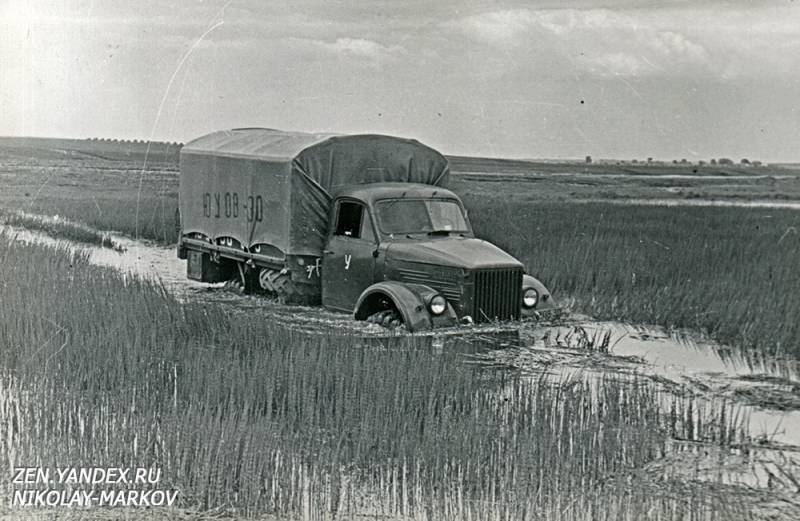
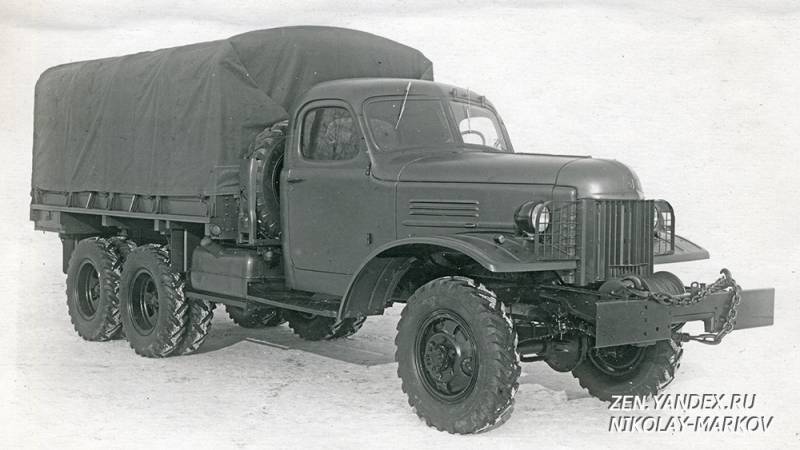
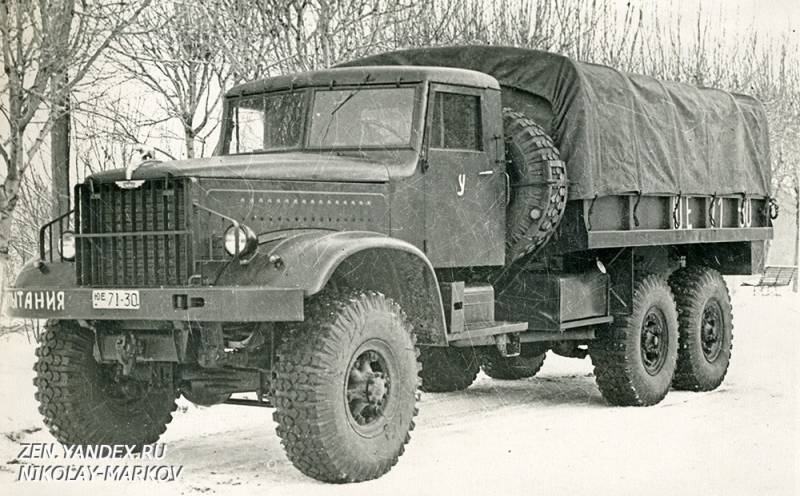
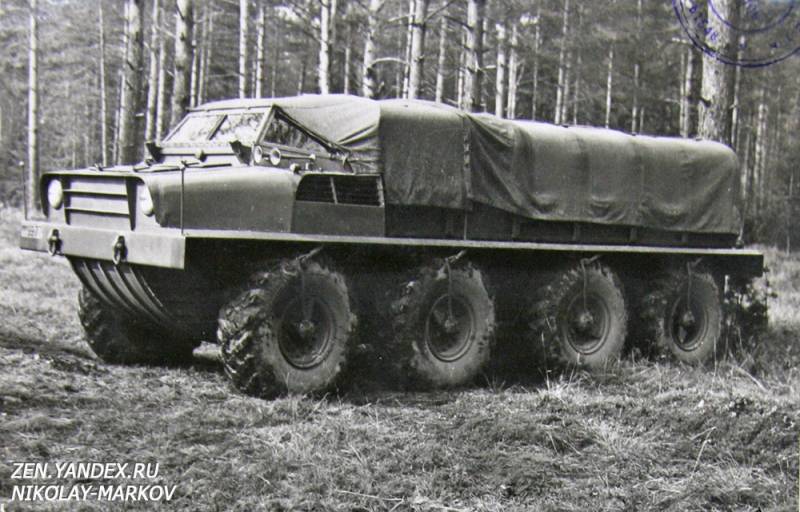
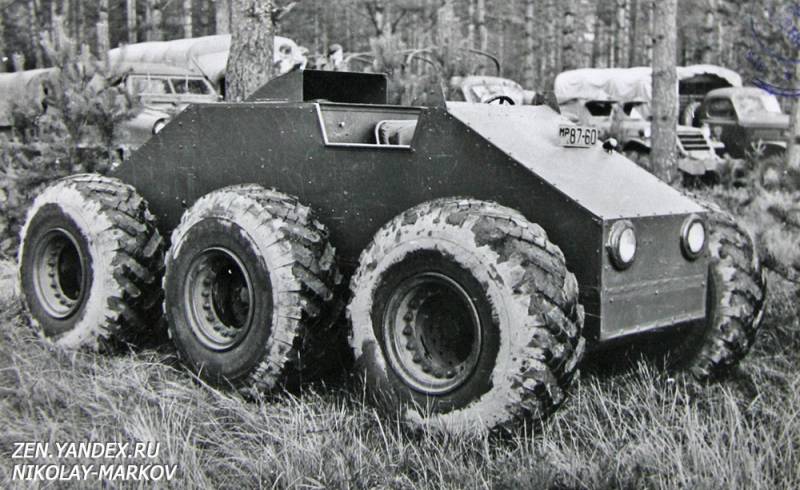
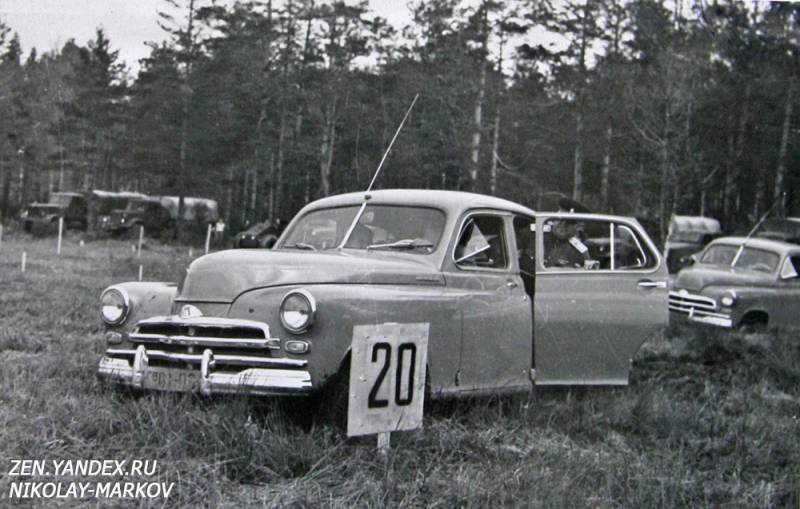
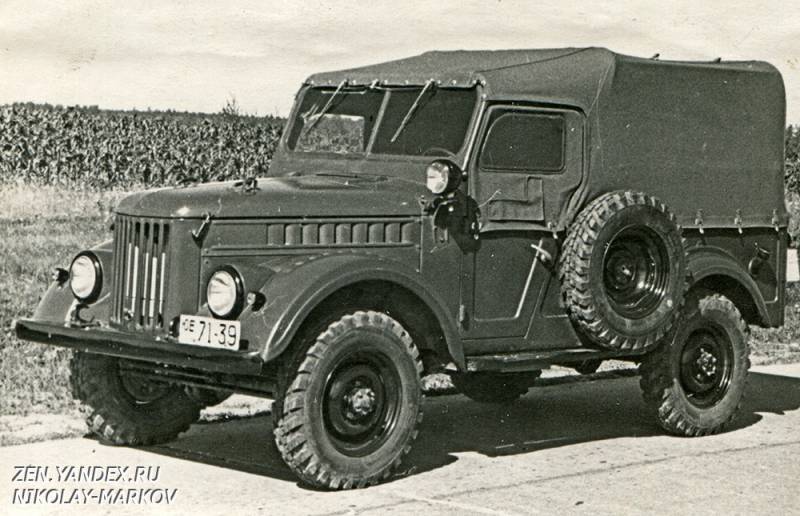
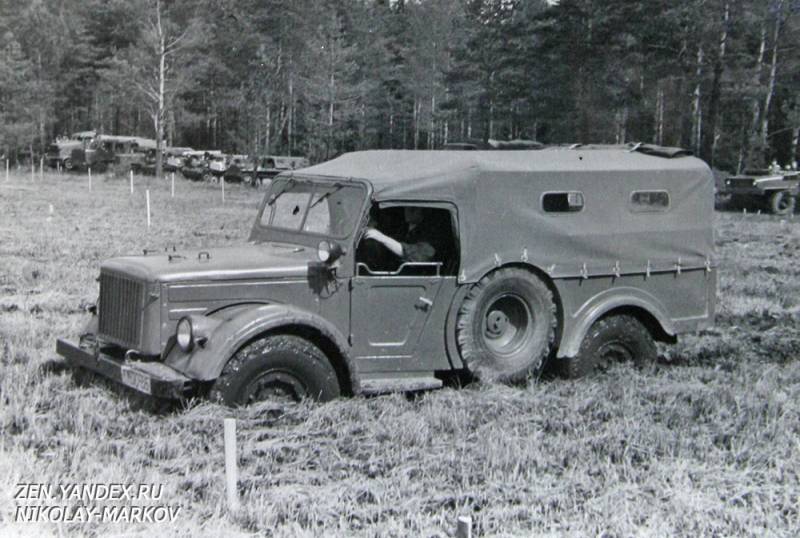
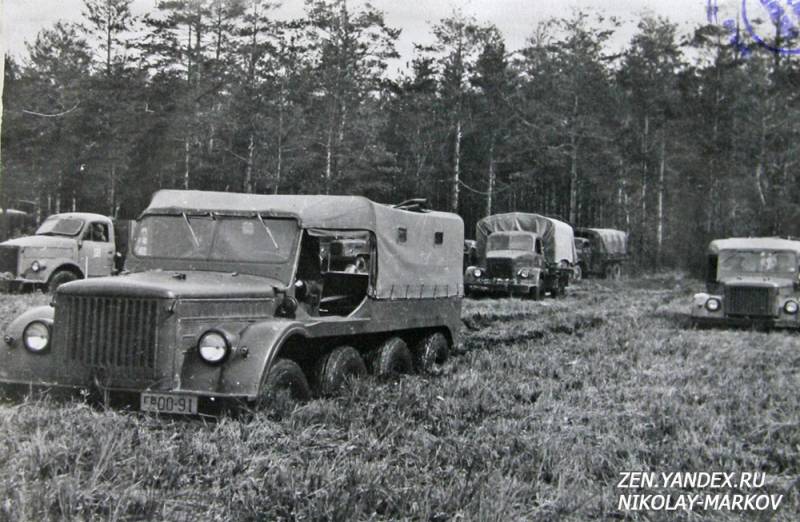
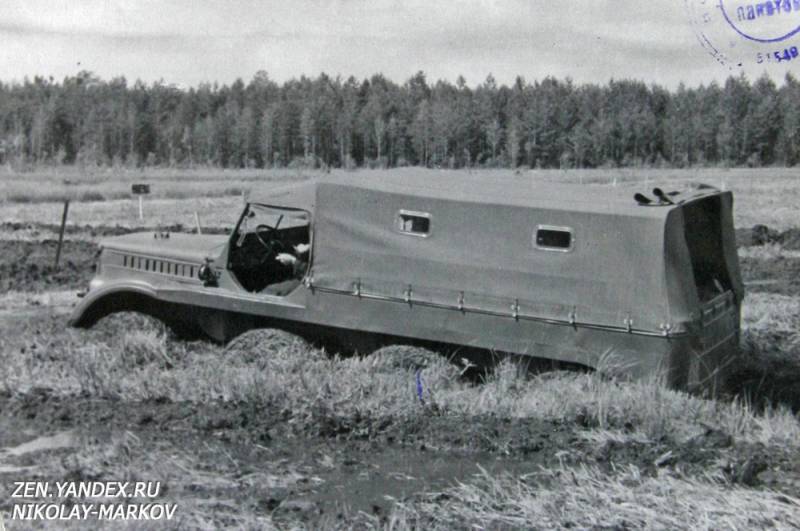
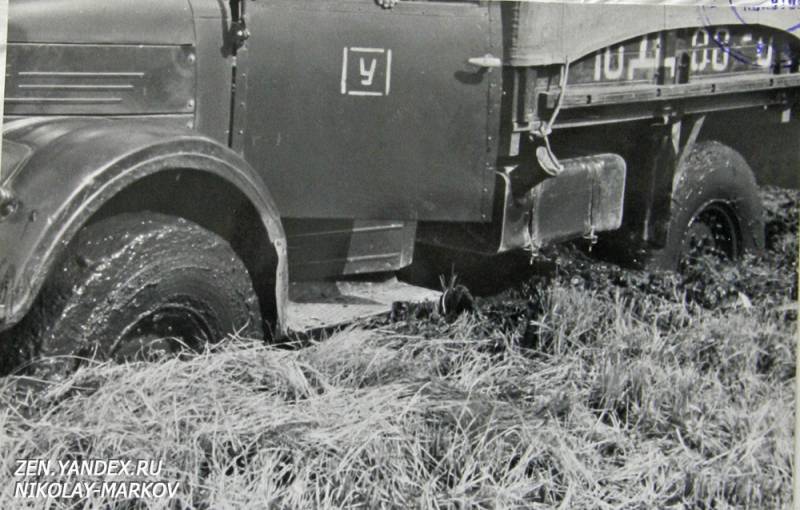
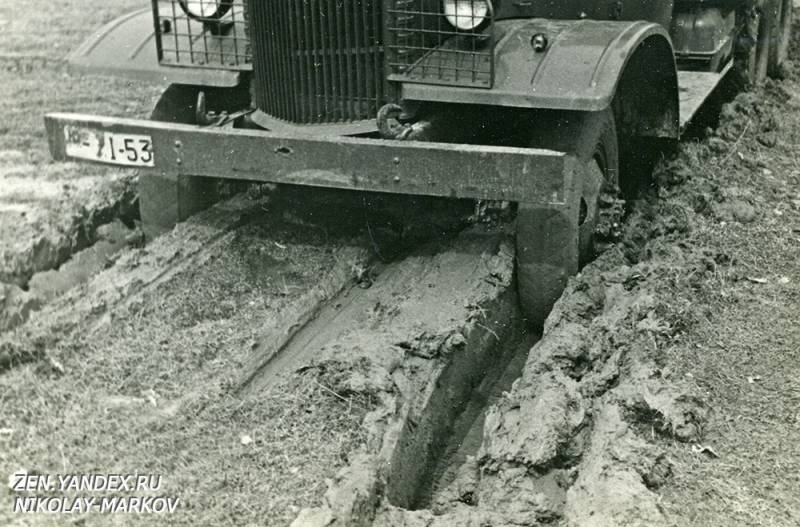
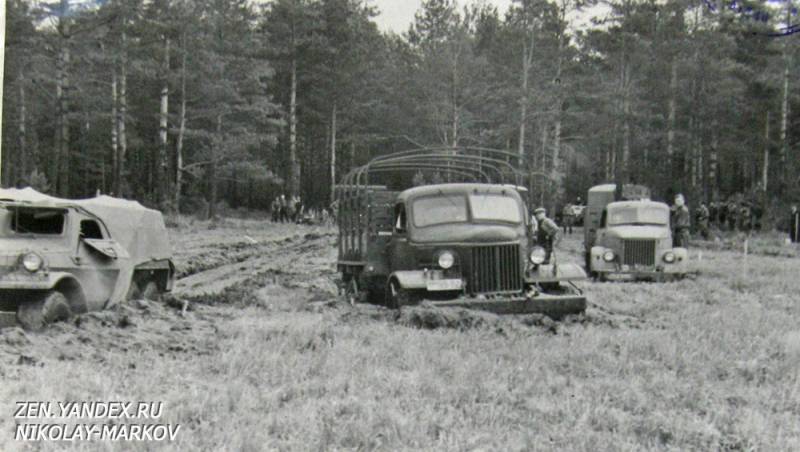
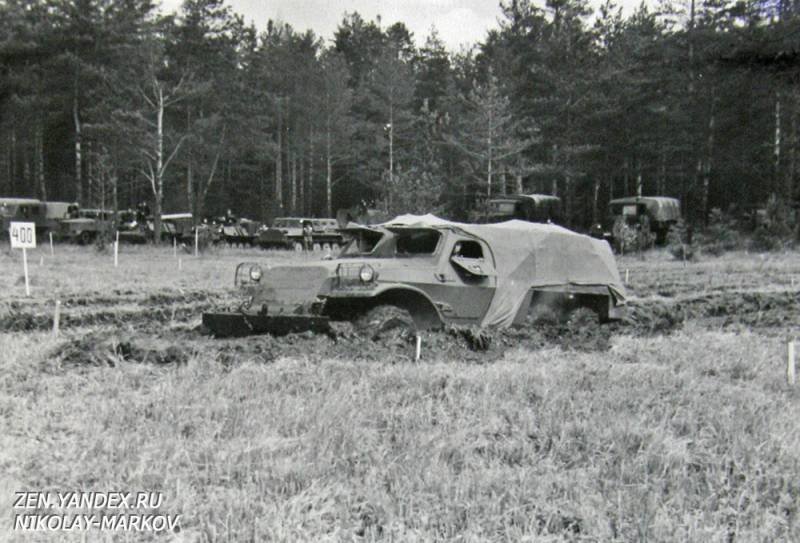
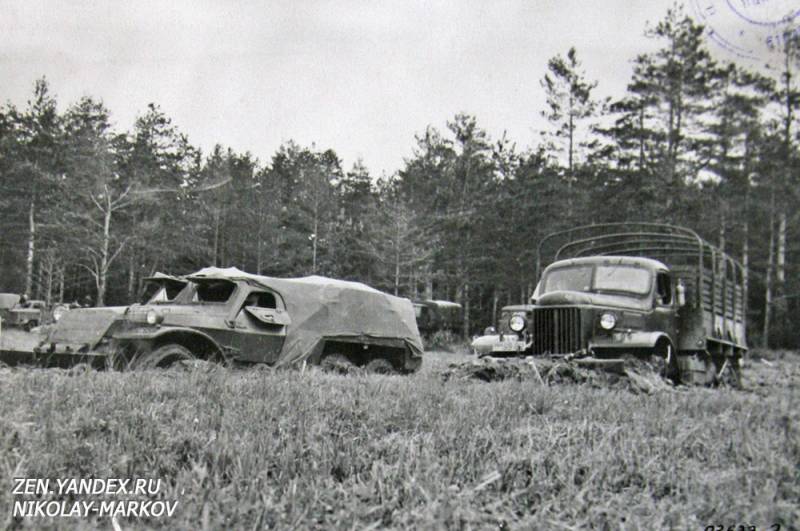
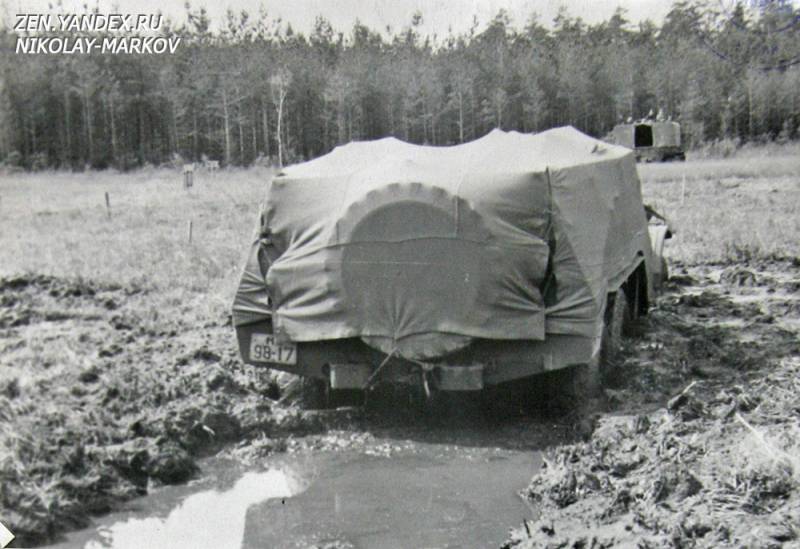
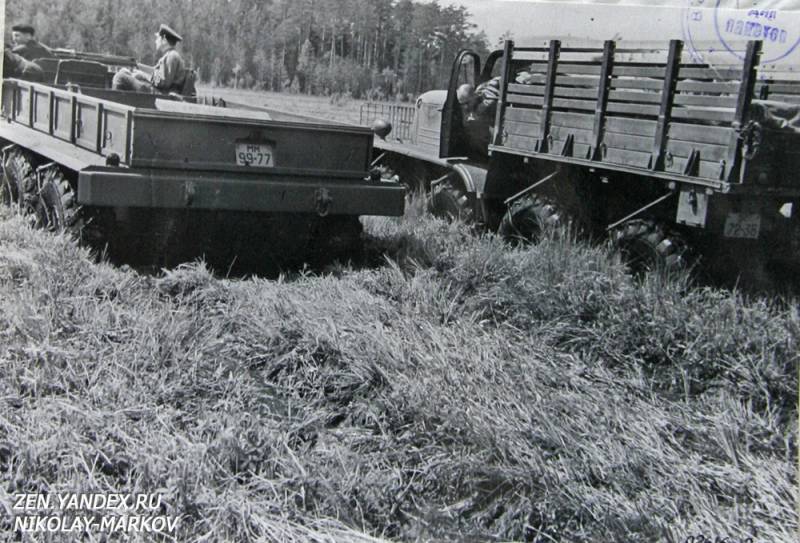
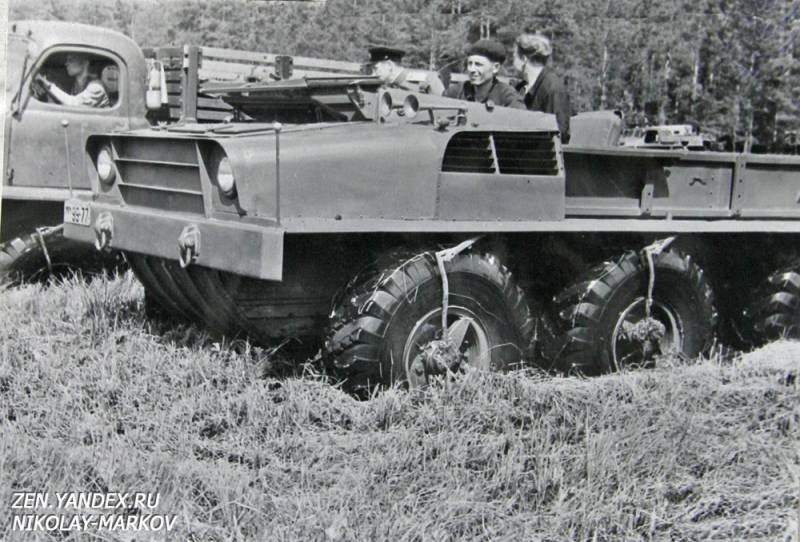
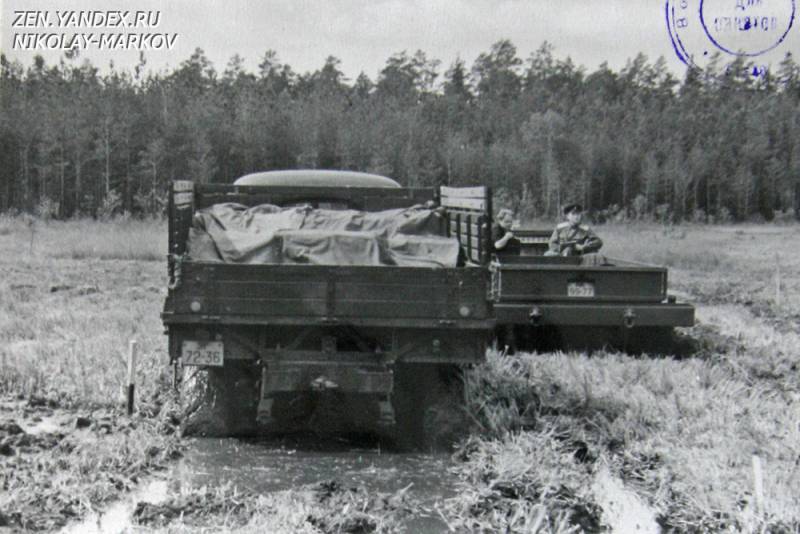
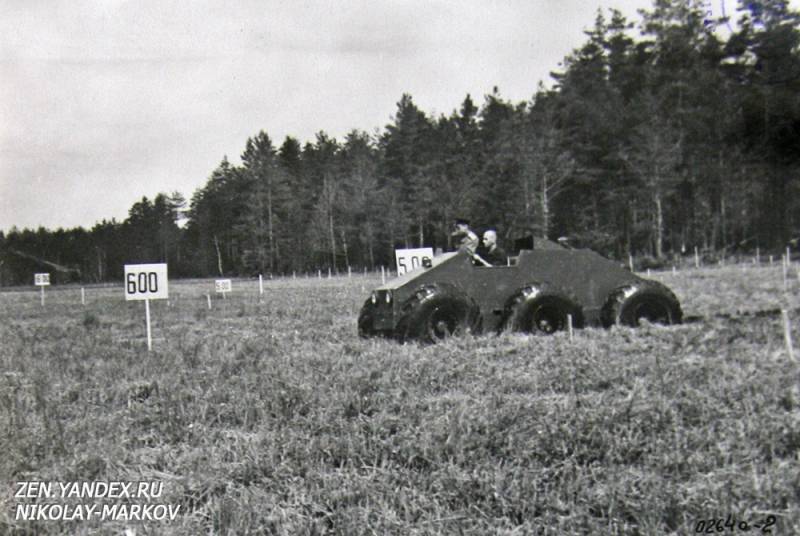
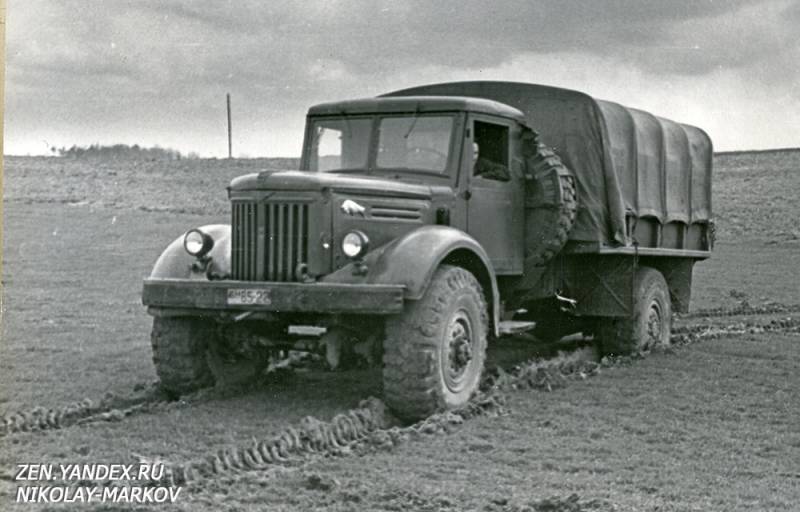
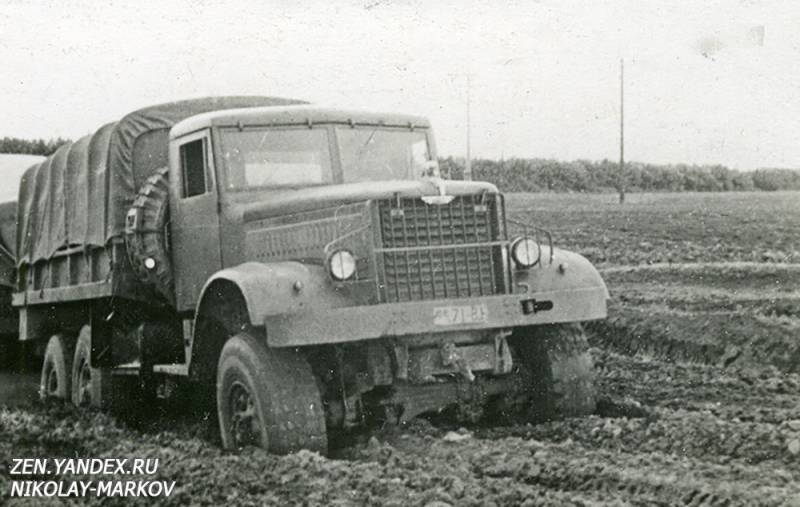
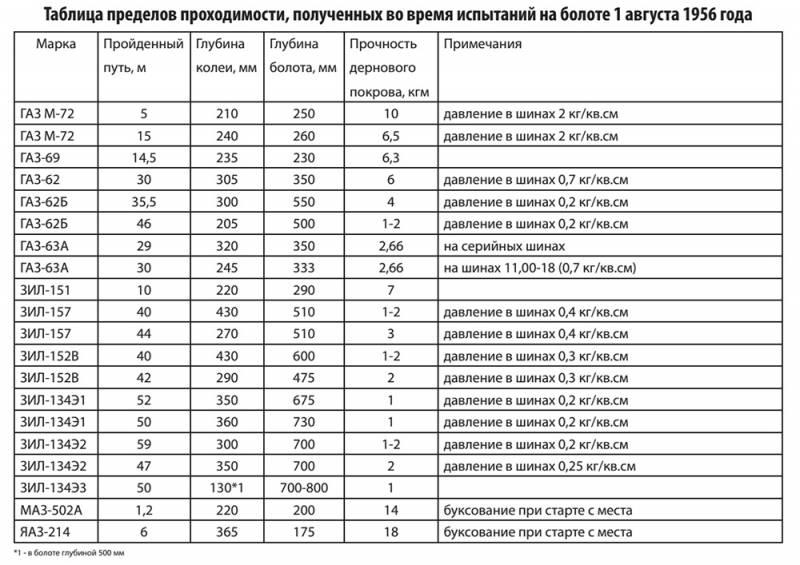
Information